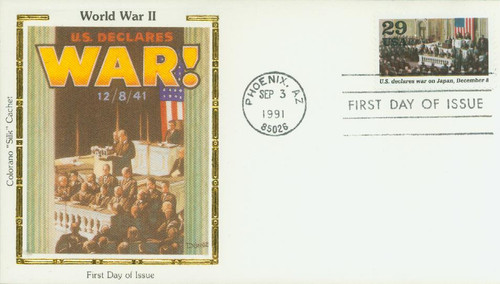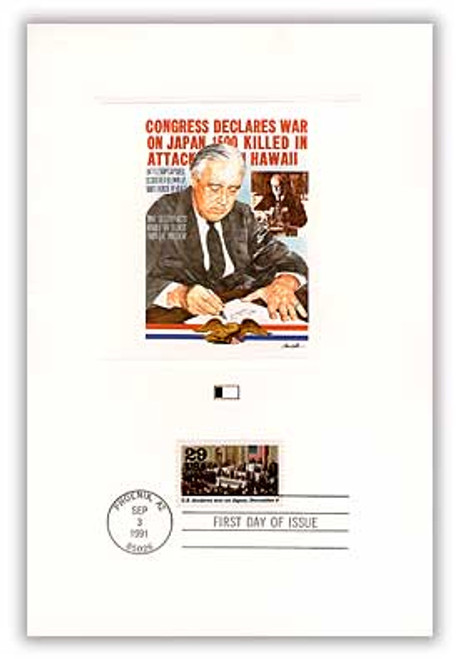
# 2559j - 1991 29c World War II: U.S. Declares War on Japan
US #2559j
1991 U.S. Declares War on Japan, December 8
- From first sheet in series commemorating WW2
- Sheet highlights events that took place in 1941
Category of Stamp: Commemorative
Set: 1941: A World at War, World War II
Value: 29¢, First Class Mail rate
First Day of Issue: September 3, 1991
First Day City: Phoenix, Arizona
Quantity Issued: 15,218,000
Printed by: Bureau of Engraving and Printing
Printing Method: Lithographed and engraved
Format: Miniature sheets of 10 stamps, with a strip of five along the top and another along the bottom, with a world map in the center.
Perforations: 11
Reason the stamp was issued: The miniature sheet was issued in honor of the 50th anniversary of America entering World War II.
About the stamp design: There were many topics the USPS wanted to cover when commemorating World War II, but those planning the series didn’t want to issue a large number of individual stamps. It was decided a sheetlet format would best highlight the main events of the war. In order for all the sheetlets to have a uniform design, the same artist, William Bond, and art director, Howard Paine, were assigned to the entire project. The Burma Road stamp pictures the winding, mountainous road that snaked through Burma and into China. Military vehicles are traveling the route. Bond painted the scene using acrylic paint.
The 1941 sheet also features the Peacetime Draft, the Lend-Lease agreement, Civil Defense, the Atlantic Charter meeting, Pearl Harbor, the US declaration of war, and more.
First Day City: The First Day of Issue ceremony took place during the opening ceremonies of the American Legion conference in Phoenix, Arizona.
Unusual thing about this stamp: The design for this World War II sheet was unveiled during a White House ceremony. President George H. W. Bush, who was a US Navy pilot during the war, participated in the unveiling ceremony.
About the World War II Series: As the 50th anniversary of World War II was approaching, the US Postal Service wanted a series that would recognize the key events of the war and the important contributions America made to the Allied victory. Rather than issue a large number of stamps, the USPS decided to create five sheetlets, each commemorating one year of America’s involvement in the war. Each sheetlet had 10 different stamps arranged in two horizontal strips of 5. In the center was a world map with Allied and neutral nations in yellow and Axis-controlled areas in red. Notes on the map highlighted key developments that occurred that year. The stamps each featured important events that took place during the year, as well.
History the stamp represents:
U.S. Declares War on Japan, December 8
The day after Pearl Harbor was attacked, President Roosevelt addressed a joint session of Congress and the American people. Calling December 7, 1941, “a date which will live in infamy,” he asked Congress to declare war on Japan. Both houses immediately voted to enact the President’s request. Three days later, Germany and Italy declared war on the US. Congress, in turn, voted unanimously to declare war on them as well. The US had officially entered World War II.
US #2559j
1991 U.S. Declares War on Japan, December 8
- From first sheet in series commemorating WW2
- Sheet highlights events that took place in 1941
Category of Stamp: Commemorative
Set: 1941: A World at War, World War II
Value: 29¢, First Class Mail rate
First Day of Issue: September 3, 1991
First Day City: Phoenix, Arizona
Quantity Issued: 15,218,000
Printed by: Bureau of Engraving and Printing
Printing Method: Lithographed and engraved
Format: Miniature sheets of 10 stamps, with a strip of five along the top and another along the bottom, with a world map in the center.
Perforations: 11
Reason the stamp was issued: The miniature sheet was issued in honor of the 50th anniversary of America entering World War II.
About the stamp design: There were many topics the USPS wanted to cover when commemorating World War II, but those planning the series didn’t want to issue a large number of individual stamps. It was decided a sheetlet format would best highlight the main events of the war. In order for all the sheetlets to have a uniform design, the same artist, William Bond, and art director, Howard Paine, were assigned to the entire project. The Burma Road stamp pictures the winding, mountainous road that snaked through Burma and into China. Military vehicles are traveling the route. Bond painted the scene using acrylic paint.
The 1941 sheet also features the Peacetime Draft, the Lend-Lease agreement, Civil Defense, the Atlantic Charter meeting, Pearl Harbor, the US declaration of war, and more.
First Day City: The First Day of Issue ceremony took place during the opening ceremonies of the American Legion conference in Phoenix, Arizona.
Unusual thing about this stamp: The design for this World War II sheet was unveiled during a White House ceremony. President George H. W. Bush, who was a US Navy pilot during the war, participated in the unveiling ceremony.
About the World War II Series: As the 50th anniversary of World War II was approaching, the US Postal Service wanted a series that would recognize the key events of the war and the important contributions America made to the Allied victory. Rather than issue a large number of stamps, the USPS decided to create five sheetlets, each commemorating one year of America’s involvement in the war. Each sheetlet had 10 different stamps arranged in two horizontal strips of 5. In the center was a world map with Allied and neutral nations in yellow and Axis-controlled areas in red. Notes on the map highlighted key developments that occurred that year. The stamps each featured important events that took place during the year, as well.
History the stamp represents:
U.S. Declares War on Japan, December 8
The day after Pearl Harbor was attacked, President Roosevelt addressed a joint session of Congress and the American people. Calling December 7, 1941, “a date which will live in infamy,” he asked Congress to declare war on Japan. Both houses immediately voted to enact the President’s request. Three days later, Germany and Italy declared war on the US. Congress, in turn, voted unanimously to declare war on them as well. The US had officially entered World War II.









